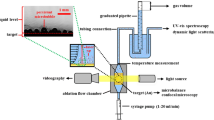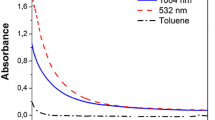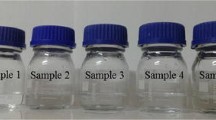Abstract
During laser ablation a mechanical impulse is generated on the target material. This allows to generate thrust on far objects, becoming an attractive space propulsion technique for space debris removal and nanosatellite propulsion. Polymers showed promising results as fuel materials for laser ablation propulsion (LAP) for nanosatellites, and among the commercial ones poly(vinyl chloride) (PVC) gave the best performances. This polymer, however, is transparent for wavelengths\(>{200}\, \hbox {nm}\), so that strategies have been tried to increase its absorption and enable laser ablation, among which the loading of carbon nanoparticles (CNPs) as absorbers. Despite the growing number of reports, the role of CNPs size and concentration is still not clear. In this work, different sizes and number density of CNPs are employed as absorbers in order to investigate their role in the impulse generation process. Samples are characterized from the structural, optical and thermodynamical point of view, and laser generated impulse is measured for fluences \({<7}\,\hbox {J}/\hbox {cm}^{2}\) by using a specifically designed ballistic pendulum. Our results show that the main parameter is CNPs number density. For a fixed total mass concentration, a reduced CNP size increases optical absorption and lowers the fluence threshold of impulse generation (\(F_{\text {th}}\)) because of a better heat distribution in the sample. A lower limit was also found for \(F_{\text {th}}\) at high absorption. Additionally, a considerable enhancement in impulse generation was observed by confining laser ablation with a transparent PVC layer.













Similar content being viewed by others
Data Availability
The datasets generated during and analysed during the current study are available from the corresponding author on reasonable request.
References
C. Phipps, M. Birkan, W. Bohn, H.-A. Eckel, H. Horisawa, T. Lippert, M. Michaelis, Y. Rezunkov, A. Sasoh, W. Schall, S. Scharring, J. Sinko, Review: Laser-ablation propulsion. J. Propuls. Power 26(4), 609–637 (2010). https://doi.org/10.2514/1.43733
C.R. Phipps, in Laser ablation propulsion and its applications in space. by P.M. Ossi (ed) (Springer, Cham, 2018), pp.217–246. https://doi.org/10.1007/978-3-319-96845-2_8
M. Shan, J. Guo, E. Gill, Review and comparison of active space debris capturing and removal methods. Prog. Aerosp. Sci. 80, 18–32 (2016). https://doi.org/10.1016/j.paerosci.2015.11.001
C.P. Mark, S. Kamath, Review of active space debris removal methods. Space Policy 47, 194–206 (2019). https://doi.org/10.1016/j.spacepol.2018.12.005
J.D. Liddle, A.P. Holt, S.J. Jason, K.A. O’Donnell, E.J. Stevens, Space science with cubesats and nanosatellites. Nat. Astron. 4(11), 1026–1030 (2020)
X.-T. Zhao, F. Tang, B. Han, X.-W. Ni, The influence of laser ablation plume at different laser incidence angle on the impulse coupling coefficient with metal target. J. Appl. Phys. 120(21), 213103 (2016). https://doi.org/10.1063/1.4971247
B. Wang, Laser ablation impulse generated by irradiating aluminum target with nanosecond laser pulses at normal and oblique incidence. Appl. Phys. Lett. 110(1), 014101 (2017). https://doi.org/10.1063/1.4973464
C. Phipps, J. Luke, D. Funk, D. Moore, J. Glownia, T. Lippert, Laser impulse coupling at 130fs. Appl. Surf. Sci. 252(13), 4838–4844 (2006). https://doi.org/10.1016/j.apsusc.2005.07.079. (Proceedings of the European Materials Research society 2005 - Symposium-J: Advances in Laser and Lamp Processing of Functional Materials)
C.R. Phipps, M. Boustie, J.M. Chevalier, S. Baton, E. Brambrink, L. Berthe, M. Schneider, L. Videau, S.A.E. Boyer, S. Scharring, Laser impulse coupling measurements at 400 fs and 80 ps using the luli facility at 1057 nm wavelength. J. Appl. Phys. 122(19), 193103 (2017). https://doi.org/10.1063/1.4997196
C. Phipps, J. Luke, Diode laser-driven microthrusters: a new departure for micropropulsion. AIAA J. 40(2), 310–318 (2002). https://doi.org/10.2514/2.1647
L. Urech, T. Lippert, C.R. Phipps, A. Wokaun, Polymer ablation: from fundamentals of polymer design to laser plasma thruster. Appl. Surf. Sci. 253(15), 6409–6415 (2007). https://doi.org/10.1016/j.apsusc.2007.01.026. (Proceedings of the Fifth International Conference on Photo-Excited Processes and Applications)
P. Battocchio, J. Terragni, V. Cristino, N. Bazzanella, R. Checchetto, M. Orlandi, S. Caramori, A. Miotello, Poly(vinyl chloride) coupling with UV laser radiation: comparison between polymer absorbers and nanoparticles to increase efficiency for laser ablation propulsion. J. Phys. Chem. C 125(51), 28088–28099 (2021). https://doi.org/10.1021/acs.jpcc.1c08175
M.M.S. Gualini, S.A. Khan, S. Iqbal, Comparative study of plastics as propellants for laser ablation plasma thrusters. J. Propuls. Power 25(5), 1138–1140 (2009). https://doi.org/10.2514/1.40318
D.K. Wang, Y.J. Hong, Interaction of high power laser with carbon doped PVC. Appl. Mech. Mech. Eng. III 249, 983–986 (2013). https://doi.org/10.4028/www.scientific.net/AMM.249-250.983
H. Koizumi, T. Inoue, K. Kojima, K. Mori, K. Komurasaki, Y. Arakawa, Microthruster experiment using a diode laser (2003). https://doi.org/10.2514/6.2003-4568
X. Wen, D.E. Hare, D.D. Dlott, Laser polymer ablation threshold lowered by nanometer hot spots. Appl. Phys. Lett. 64(2), 184–186 (1994). https://doi.org/10.1063/1.111526
R.W. Conner, D.D. Dlott, Time-resolved spectroscopy of initiation and ignition of flash-heated nanoparticle energetic materials. J. Phys. Chem. C 116(28), 14737–14747 (2012). https://doi.org/10.1021/jp303077f
G. Ischia, M. Cutillo, G. Guella, N. Bazzanella, M. Cazzanelli, M. Orlandi, A. Miotello, L. Fiori, Hydrothermal carbonization of glucose: secondary char properties, reaction pathways, and kinetics. Chem. Eng. J. 449, 137827 (2022). https://doi.org/10.1016/j.cej.2022.137827
A.D. Goswami, D.H. Trivedi, N.L. Jadhav, D.V. Pinjari, Sustainable and green synthesis of carbon nanomaterials: a review. J. Environ. Chem. Eng. 9(5), 106118 (2021). https://doi.org/10.1016/j.jece.2021.106118
Z. Wang, D. Shen, C. Wu, S. Gu, State-of-the-art on the production and application of carbon nanomaterials from biomass. Green Chem. 20(22), 5031–5057 (2018)
P. Battocchio, J. Terragni, N. Bazzanella, C. Cestari, M. Orlandi, W.J. Burger, R. Battiston, A. Miotello, Ballistic measurements of laser ablation generated impulse. Meas. Sci. Technol. 32(1), 015901 (2021). https://doi.org/10.1088/1361-6501/abace6
J. Terragni, P. Battocchio, N. Bazzanella, M. Orlandi, W.J. Burger, R. Battiston, A. Miotello, Evaluation of the role of beam homogeneity on the mechanical coupling of laser-ablation-generated impulse. Appl. Opt. 60(31), 37–44 (2021). https://doi.org/10.1364/AO.432991
J.-P. Song, K.-Y. Tian, L.-X. Ma, W. Li, S.-C. Yao, The effect of carbon black morphology to the thermal conductivity of natural rubber composites. Int. J. Heat Mass Transf. 137, 184–191 (2019). https://doi.org/10.1016/j.ijheatmasstransfer.2019.03.078
Electromagnetic Theory, pp. 12–56. Wiley (1998). Chap. 2. https://doi.org/10.1002/9783527618156.ch2
X. Zhang, J. Qiu, X. Li, J. Zhao, L. Liu, Complex refractive indices measurements of polymers in visible and near-infrared bands. Appl. Opt. 59(8), 2337–2344 (2020). https://doi.org/10.1364/AO.383831
W. Mäntele, E. Deniz, Uv–vis absorption spectroscopy: Lambert–Beer reloaded. Spectrochim. Acta Part A Mol. Biomol. Spectrosc. 173, 965–968 (2017). https://doi.org/10.1016/j.saa.2016.09.037
H. Koizumi, T. Inoue, K. Komurasaki, Y. Arakawa, Fundamental characteristics of a laser ablation microthruster. Trans. Japan Soc. Aeronaut. Space Sci. 50(167), 70–76 (2007). https://doi.org/10.2322/tjsass.50.70
Z. Zheng, J. Zhang, Y. Zhang, F. Liu, M. Chen, X. Lu, Y. Li, Enhancement of coupling coefficient of laser plasma propulsion by water confinement. Appl. Phys. A 85(4), 441–443 (2006)
M. Senegačnik, M. Jezeršek, P. Gregorčič, Propulsion effects after laser ablation in water, confined by different geometries. Appl. Phys. A 126(2), 1–12 (2020)
J.E. Sinko, N.B. Dhote, A.V. Pakhomov, Laser propulsion with liquid propellants part II: thin films. AIP Conf. Proc. 997(1), 209–221 (2008). https://doi.org/10.1063/1.2931892
R. Fabbro, J. Fournier, P. Ballard, D. Devaux, J. Virmont, Physical study of laser-produced plasma in confined geometry. J. Appl. Phys. 68(2), 775–784 (1990). https://doi.org/10.1063/1.346783
J. Yu, L. Sun, C. Ma, Y. Qiao, H. Yao, Thermal degradation of PVC: a review. Waste Manag. 48, 300–314 (2016). https://doi.org/10.1016/j.wasman.2015.11.041
A. Jiménez, V. Berenguer, J. López, A. Sánchez, Thermal degradation study of poly(vinyl chloride): kinetic analysis of thermogravimetric data. J. Appl. Polym. Sci. 50(9), 1565–1573 (1993). https://doi.org/10.1002/app.1993.070500910
Funding
No funding was received for conducting this study.
Author information
Authors and Affiliations
Corresponding author
Ethics declarations
Conflict of interest
The authors declare no conflicts of interests.
Rights and permissions
Springer Nature or its licensor (e.g. a society or other partner) holds exclusive rights to this article under a publishing agreement with the author(s) or other rightsholder(s); author self-archiving of the accepted manuscript version of this article is solely governed by the terms of such publishing agreement and applicable law.
About this article
Cite this article
Battocchio, P., Bazzanella, N., Orlandi, M. et al. Carbon nanoparticles as absorbers in PVC for laser ablation propulsion: size effects. Appl. Phys. A 129, 220 (2023). https://doi.org/10.1007/s00339-023-06502-7
Received:
Accepted:
Published:
DOI: https://doi.org/10.1007/s00339-023-06502-7




